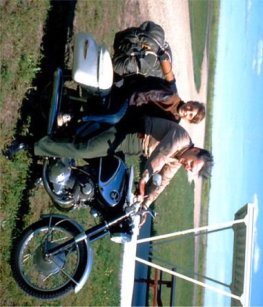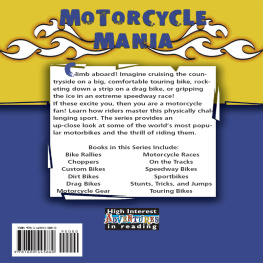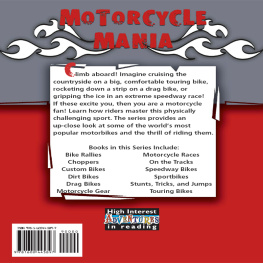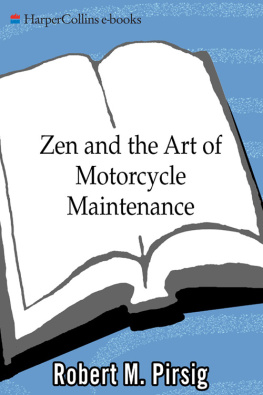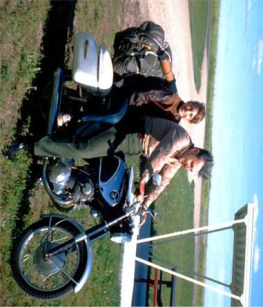Basic Motorcycle Maintenance
How to Service and Maintain Your Motorcycle
Peter Karmios
Introduction to Basic Motorcycle Servicing
W elcome to the Bike Smart Motorcycle Maintenance book! This book is designed to cover a basic service on most types of motorcycle through a number of theory sessions and practical exercises aimed at the beginner.
Ever wanted to know how to service your bike?
Not the engine stripping, race tuning, complete rebuild type of knowledge gained by qualified mechanics; just simple, basic tasks like adjusting a chain, checking tyre pressures, oil changing and how to carry out basic service checks?
Even if you dont intend to work on your own bike, having that knowledge will make you more aware of your bikes condition, its safety and the likely cost of paying someone to carry out that servicing. Most motorcycle training schools cover very basic service checks at CBT level. However, as instructors we are constantly asked to include additional training so that individuals can look after their bikes more effectively.
With this need in mind, we have produced this book designed to show riders how to carry out a basic service on their own machine. Basic servicing is easily within the ability of most riders and minimal tools are required.
Basic servicing is common to most types of motorcycle, but details like tyre pressures, types of engine oil and torque settings can vary greatly from one bike to another. Thats why the course is designed to work with an owners service manual, which will provide specific information for the bike being worked on.
This book is intended to guide you through a basic service on your own machine, and how much you choose to carry out is entirely up to you. But, above all, enjoy the course getting your hands dirty while saving money and looking after your bike can be great fun!
Peter Karmios,
Author.
The BOLTS Motorcycle Maintenance Checks
T his book is based on a well known acronym, which itemizes the checks that should be regularly carried out on any motorcycle.
These checks can be conducted as a quick check over your machine each morning before dashing off to work, or as a thorough examination of your bike as part of a basic service.
Use the checklist methodically. Start at the front of your machine, with the bike on its centre stand, if it has one, and on a flat, level surface as this will make the checking of fluid levels easier.
Begin with the front wheel and check each item on the BOLTS list as you work back along your bike. Take time to inspect your bike thoroughly whenever possible and make a note of any problems.
BOLTS Motorcycle Maintenance Checks
If your tyre pressures are slowly dropping between checks, or that fork seal leak is getting worse, or the tail lights not working - then nows the time to do something about it. The problem will only get worse and the cost of repair greater!
Cleaning your bike regularly will help to prevent corrosion and make it easier to spot any problems at an early stage. Dont forget to lubricate your drive chain after washing And a clean bike makes servicing less messy!
Finally, make sure that there are no loose items such as number plate screws or fasteners. Mirrors, lights & reflectors should be clean and unbroken. A regular BOLTS check of your bike will help to keep it in top condition!
The BOLTS Checklist
This section will look at the "BOLTS" checklist and how to use it as a quick, start of day safety check and also how to use it for more in depth periodic maintenance. Always refer to your owner's or workshop manual for your motorcycles's specific fluid levels, tyre pressures, torque settings etc.
Brakes
Oils & Fluids
Lights & Electrics
Tyres & Wheels
Steering
Suspension
Sprockets, chain, shaft drive
Stands
The BOLTS Checklist
Brakes
Check for correct adjustment. Ensure cables run smoothly.
Check cables for fraying and hoses for cracks and splits.
Check the brake wear indicators.
Brake reservoir levels should be above the minimum mark.
Oils & Fluids
Check oil level dipstick or sight glass while machine is on level ground.
Also battery, coolant and hydraulic reservoirs (clutch).
Lights & Electrics
Check all electrics: lights, horn & emergency cut out/kill switch.
Check security of plug lead(s) if accessable .
Tyres & Wheels
The UK Legal requirement for motorcycles is 1mm over of width for entire circumference. For mopeds the requirement is merely "visible" tread.
Spin wheels for trueness & soundness of spokes.
Check tyres for cuts & bulges.
Check for play in wheel bearings and forks.
Check for correct tyre pressures.
Steering
Check head bearings for free movement, worn bearings (feels notchy) & too much slack.
Swing handlebars from full left to full right, checking for any stretching or pinching of wires and cables. Look for any obstructions to full and free movement of the handlebars.
Suspension
Compress front forks & look for oil seal leaks.
Check rear suspension movement & pivot wear.
Sprockets & Chain
These are prone to wear and require regular inspection, adjustment and lubrication. It is important to maintain correct tension.
Check for correct adjustment adjust if necessary.
Check for excessive wear on chain and sprockets.
Lubricate with a suitable chain lubricant.
Stands
Side and main stands need to be secure & lubricated so that they swing up and out of the way. Do not sit on the bike while it is on the stand as this can place unnecessary strain & wear on the stand.
Finally, make sure that there are no loose items such as the number plate or fasteners. Mirrors, lights & reflectors should be clean and unbroken.
Keeping the whole bike clean on a regular basis will make it easier to spot any problems at an early stage.
Your Owners Manual
This book is designed to work with an owners manual or workshop manual that contains all the specific data to carry out a service on your motorcycle.
Even a basic service requires a degree of knowledge and information that may be unique to your bike. It is surprising how much variation there is in, say, tyre pressures from one bike to the next. Oil grades and volumes vary greatly, as does the correct chain tension from a sports bike to a trials bike. Knowing your own machine is hugely important to looking after it effectively. You may find it useful to write down the most common bits of information and keep it on your bike for reference.


